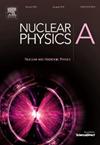Investigating triply heavy tetraquark states through QCD sum rules
IF 2.5
4区 物理与天体物理
Q2 PHYSICS, NUCLEAR
引用次数: 0
Abstract
We apply the method of QCD sum rules to study the and tetraquark states, where and , with the quantum number . We consider the contributions of vacuum condensates up to dimension-9 in the operator product expansion, and use the energy scale formula to determine the optimal energy scales for the QCD spectral densities. Our results indicate that triply charm tetraquark states and have masses in the ranges of and , respectively. In the bottom sector, triply bottom tetraquark states and have masses in the ranges of and , respectively. This study could help distinguish these states in upcoming high-energy nuclear and particle experiments.
用QCD和规则研究三重重四夸克态
应用QCD求和规则的方法研究了QQQ¯q¯和QQQ¯s¯四夸克态,其中q= c,b和q=u,d,量子数JP=0+。在算子积展开中,我们考虑了真空凝析物对-9维的贡献,并使用能量尺度公式μ=MX2−(iMc+jMb)2−kMs来确定QCD谱密度的最佳能量尺度。结果表明,三粲四夸克态ccc¯q¯和ccc¯s¯的质量范围分别为5.38 ~ 5.84GeV和5.66 ~ 6.16GeV。在底扇区,三底四夸克态bbb¯q¯和bbb¯s¯的质量范围分别为14.89 ~ 15.55GeV和14.95 ~ 15.66GeV。这项研究可以帮助在即将到来的高能核和粒子实验中区分这些状态。
本文章由计算机程序翻译,如有差异,请以英文原文为准。
求助全文
约1分钟内获得全文
求助全文
来源期刊

Nuclear Physics A
物理-物理:核物理
CiteScore
3.60
自引率
7.10%
发文量
113
审稿时长
61 days
期刊介绍:
Nuclear Physics A focuses on the domain of nuclear and hadronic physics and includes the following subsections: Nuclear Structure and Dynamics; Intermediate and High Energy Heavy Ion Physics; Hadronic Physics; Electromagnetic and Weak Interactions; Nuclear Astrophysics. The emphasis is on original research papers. A number of carefully selected and reviewed conference proceedings are published as an integral part of the journal.
 求助内容:
求助内容: 应助结果提醒方式:
应助结果提醒方式:


